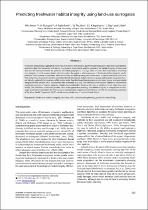JavaScript is disabled for your browser. Some features of this site may not work without it.
- ResearchSpace
- →
- Research Publications/Outputs
- →
- Journal Articles
- →
- View Item
| dc.contributor.author |
Amis, MA

|
|
| dc.contributor.author |
Rouget, M

|
|
| dc.contributor.author |
Balmford, A

|
|
| dc.contributor.author |
Thuiller, W

|
|
| dc.contributor.author |
Kleynhans, CJ

|
|
| dc.contributor.author |
Day, DJC

|
|
| dc.contributor.author |
Nel, JL

|
|
| dc.date.accessioned | 2007-07-02T12:46:53Z | |
| dc.date.available | 2007-07-02T12:46:53Z | |
| dc.date.issued | 2007-04 | |
| dc.identifier.citation | Amis, MA et al. 2007. Predicting freshwater habitat integrity using land-use surrogates. Water SA, Vol. 33(2), pp 215-222 | en |
| dc.identifier.issn | 0378-4738 | |
| dc.identifier.uri | http://hdl.handle.net/10204/840 | |
| dc.description | Copyright: 2007 Water Research Commission | en |
| dc.description.abstract | Freshwater biodiversity is globally threatened due to human disturbances, but freshwater ecosystems have been accorded less protection than their terrestrial and marine counterparts. Few criteria exist for assessing the habitat integrity of rivers and data used for such assessments are generally of limited geographical coverage. Here, a fine-scale dataset describing river integrity in north-western is used. South Africa is to explore the extent to which measures of freshwater habitat integrity can be predicted from remotely sensed data, which are readily available in many parts of the world. A spatial statistical model was built using broad land-cover variables to predict the habitat integrity (subdivided into riparian and instream integrity) of rivers. The importance of the spatial scale is also explored. Results showed that riparian and, to a lesser degree, instream habitat integrity of river systems could be predicted with reasonable accuracy. The total area under natural vegetation was the most significant predictor of riparian integrity, which is best predicted by land-use activities at catchment level, rather than more locally. GIS-based model thus provides a fine-scale approach to assessing river habitat integrity as a supplement to landscape-level conservation plans for river systems, and represents a significant contribution towards the monitoring component of the River Health Programme (RHP), which reports on the state of rivers in South Africa | en |
| dc.language.iso | en | en |
| dc.publisher | Water Research Commission | en |
| dc.subject | Freshwater habitat integrity | en |
| dc.subject | Land use | en |
| dc.subject | Conservation planning | en |
| dc.subject | Predictive modelling | en |
| dc.title | Predicting freshwater habitat integrity using land-use surrogates | en |
| dc.type | Article | en |
| dc.identifier.apacitation | Amis, M., Rouget, M., Balmford, A., Thuiller, W., Kleynhans, C., Day, D., & Nel, J. (2007). Predicting freshwater habitat integrity using land-use surrogates. http://hdl.handle.net/10204/840 | en_ZA |
| dc.identifier.chicagocitation | Amis, MA, M Rouget, A Balmford, W Thuiller, CJ Kleynhans, DJC Day, and JL Nel "Predicting freshwater habitat integrity using land-use surrogates." (2007) http://hdl.handle.net/10204/840 | en_ZA |
| dc.identifier.vancouvercitation | Amis M, Rouget M, Balmford A, Thuiller W, Kleynhans C, Day D, et al. Predicting freshwater habitat integrity using land-use surrogates. 2007; http://hdl.handle.net/10204/840. | en_ZA |
| dc.identifier.ris | TY - Article AU - Amis, MA AU - Rouget, M AU - Balmford, A AU - Thuiller, W AU - Kleynhans, CJ AU - Day, DJC AU - Nel, JL AB - Freshwater biodiversity is globally threatened due to human disturbances, but freshwater ecosystems have been accorded less protection than their terrestrial and marine counterparts. Few criteria exist for assessing the habitat integrity of rivers and data used for such assessments are generally of limited geographical coverage. Here, a fine-scale dataset describing river integrity in north-western is used. South Africa is to explore the extent to which measures of freshwater habitat integrity can be predicted from remotely sensed data, which are readily available in many parts of the world. A spatial statistical model was built using broad land-cover variables to predict the habitat integrity (subdivided into riparian and instream integrity) of rivers. The importance of the spatial scale is also explored. Results showed that riparian and, to a lesser degree, instream habitat integrity of river systems could be predicted with reasonable accuracy. The total area under natural vegetation was the most significant predictor of riparian integrity, which is best predicted by land-use activities at catchment level, rather than more locally. GIS-based model thus provides a fine-scale approach to assessing river habitat integrity as a supplement to landscape-level conservation plans for river systems, and represents a significant contribution towards the monitoring component of the River Health Programme (RHP), which reports on the state of rivers in South Africa DA - 2007-04 DB - ResearchSpace DP - CSIR KW - Freshwater habitat integrity KW - Land use KW - Conservation planning KW - Predictive modelling LK - https://researchspace.csir.co.za PY - 2007 SM - 0378-4738 T1 - Predicting freshwater habitat integrity using land-use surrogates TI - Predicting freshwater habitat integrity using land-use surrogates UR - http://hdl.handle.net/10204/840 ER - | en_ZA |






